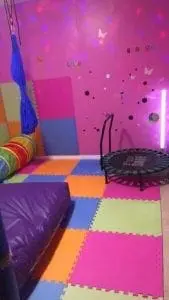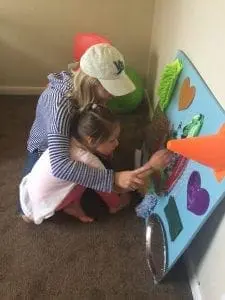DIY Sensory Rooms on a Budget!

DIY Sensory Rooms
Have you ever thought about creating a sensory room or space for your child, but thought it would be too expensive or you would need to dedicate an entire room? We know that sensory rooms have a huge calming effect on our children, so, we challenged a couple of moms (and two behavior therapists) to come up with some DIY, low-cost solutions for creating a sensory room that helped children and provided a high-quality experience.
Where to Begin?
First, consider your child and their needs; since every child is unique, the sensory space you create for them should be unique, as well.
Think about the room or space you have and how you might be able to incorporate sensory items that your child would enjoy. Keep in mind that a wall, corner or closet could also work if you do not have an entire room you can dedicate to this effort. Keep an eye out for any toys or sensory activities your child likes.
Once you have an idea in mind of the size, space and sensory items, think about how to make them all work within your budget while still beneficial for your child.
We found a lot of inspiration for our DIY sensory rooms on Pinterest, and took advantage of the dollar store and coupons for various craft and fabric stores.
Room 1
Challenge:
To provide a sensory room/calming space at church in order to help children (boys and girls) who need a “break” while their parents are attending church.
Kristin Grant began working with children with special needs when she was 13 years old, and hasn’t stopped. She currently works as a Registered Behavior Technician for Positive Behavior Support agency. Kristin also volunteers at her church every Sunday and realized that there were a lot of children with special needs at the church that were not adjusting well. She expressed it this way: “I soon learned that a lot of parents were unable to come to church  because they felt like there was no place for their child. This broke my heart and I was determined to create a room that was able to accommodate them”.
because they felt like there was no place for their child. This broke my heart and I was determined to create a room that was able to accommodate them”.
Kristin brought up her idea of a sensory room to the Director of Children’s Ministry who was totally on-board with the idea! They were able to resolve this problem by using one of the unused classrooms to create a sensory room that is calming. All of the students start out in their age-group classrooms, but if they need a break, they can come to this room. After they have had a chance to calm down, they can go back to their classroom. Or, if they would like to stay, then they can also do that.
The only pitfall encountered occurred when trying to set up the sensory swing. It didn’t come with the necessary eye-hook, but, you can find them easily at Home Depot. Just make sure they match the correct weight limit of the swing.
 Supplies/tools for sensory wall:
Supplies/tools for sensory wall:
- 2 large pieces of plywood
- Paint for the background color
- Silicon ice trays
- Calculator
- Touch lights
- Light switches
- Metal baking trays (to use for magnets)
- Roller coaster bead activity
- PVC ball chute
Supplies for PVC Ball Chute:
- 4 PVC PIPES
- 4 Elbow PVC pipes
- 4 Different colored plastic balls
- Paint to match the colors of the plastic balls
Supplies for chill zone:
- Kiddie pool
- Weighted blanket from SensaCalm
- Pillows (I got mine from Ikea)
Misc. Supplies:
- Sensory swing
- Magnetic paint for the magnetic wall
- Little black table from Ikea
- Play tunnel from Ikea
Room 2
Challenge:
To create a sensory/playroom for a little girl.
Our second room’s mom used the Internet to help her get the necessary items she needed. She ordered the majority of the items from Amazon and had them delivered  directly to her home. This, obviously, saves time (no driving around to find items) and uses the power of Amazon to get the items as inexpensively as possible.
directly to her home. This, obviously, saves time (no driving around to find items) and uses the power of Amazon to get the items as inexpensively as possible.
Her daughter now has a wonderful space to assist in the “calming down” process when she gets over-stimulated. The room is actually a very useful “tool” to use whenever the need arises to provide a space for her daughter to go. Trampolines and swings, for example, provide and promote vestibular stimulation (to assist in balance). An alternative, the less-expensive choice might also be a rocking chair or an exercise ball.
Her daughter finds the Fiber optic lights (waterfall) so calming for her visual sensory seeking! She loves to “zone out” to the cool lighting, so long as it is NOT a strobe-style lighting, which has been known to cause seizures!
She really loves the room and it is a serious lifesaver as her parents deal with severe, aggressive meltdowns, but, they can keep her safe. This also helps her to “regulate” much faster now at the same time.
- Crash Mat
- Trampoline
- Swing
- Rainbow Interlocking
- Floor Mats
- Tunnel
- Black-out blinds
- Radiance Floor light
- Waterfall sensory light kit
- Nursery Projector and
- Sound System
Sensory Friendly Colors: What colors are the best?
Greens and Blues:
According to research, children, typically, like muted tones of blue and green. These colors have shorter wavelengths than brighter colors and don’t create as much stimulation in the brain. Softer hues tend to create a lesser/lowered feeling of chaos inside them.
Pastel Colors:
Pastel colors offer a calm, peaceful feeling and might just add to the “safe-space feeling” when a child is overstimulated. These colors can  also add to more beneficial, restful sleeping and, perhaps, a better “rested” morning person, as well.
also add to more beneficial, restful sleeping and, perhaps, a better “rested” morning person, as well.
Neutral Tones:
Artistic curiosity is a common theme with children who have sensory issues. Neutral-toned paper (tans and grays) seem to work best to keep sensory issues at bay as they tend to allow for writing, painting or drawing but are muted so as not to over-stimulate.
Lights to Avoid:
Fluorescent lighting has been known to cause headaches and eye issues in people WITHOUT any sensory issues; imagine what might happen to someone who does have sensory issues? Natural light, whenever available, does a much better job of maintaining calm and improving attention.
Source/References: Jaime Vargas-Benitez et al…
Room 3
To create a sensory space shared by a brother and sister.
Kaitlin Kurutz, behavior assistant, assisted in rooms one and four. She also created a smaller sensory space in room 3. She created a smaller sensory board, filled a calming box with sensory toys and a got the little girl a Snuggle Huggle from InYard.
Room 4
Challenge:
To decorate a teen/young adult’s room for a young lady.
My daughter is 20, and could definitely benefit from a sensory room/calming space where she can unwind. However, one of our biggest challenges is that she will NOT allow anything in her room; pictures on the walls, pictures on the dressers, etc.
She does, however, like twinkling lights, glow in the dark stars and lava lamps. So, I decided to create a soft, glittery, twinkling backdrop behind her bed. Pink tulle was selected for the fabric choice because of its soft color, light weight, inexpensiveness and for the fact that you can see through it.
We wanted her to be able to see the glow in the dark stars, like she was looking up at the night sky as she was trying to go to sleep. During the day it just looks like a soft pink backdrop with glittery stick-on rhinestones placed randomly all over the top of the tulle. We decorated from about 2 feet from the top of the wall down. We purchased big, soft, furry pillows that match her comforter and, basically, turned her bed into a “big comfy couch”.
We also chose a weighted blanket which has turned out to be a wonderful addition! Even though it does have some “heft” to it, my daughter loves it and says, “it helps her sleep” and “feels like a big warm hug.” A white projector light is pointed at the wall behind her bed. We hid it in a flower arrangement on her dresser so as not to bother her.
Related: Sleep for Your Child with Special Needs – Why It’s Crucial and How to Get More of It!
We also added a beanbag chair and a “rag rug” to round out the room. She is still deciding if the beanbag chair gets to stay in her room, though. Currently, it has to go out of the room at night.
We have found that these sensory rooms are very effective in assisting parents who desire to “calm down”, or reduce the stress in, their children who have sensory issues. Each room is unique and there are countless options that are limited only by your own imagination. The emphasis of the room will be dictated by the specific issue(s) that your child has. The beauty of these rooms (no pun intended) is that they need not be expensive in order to achieve the desired result. After all, when the child is calm, the parents rest easier, too!![]()
Supplies for Wall
- Tulle Fabric
- Projection spotlight
- Rhinestone stickers
- Glow Twinkle Stars
- Thumbtacks
Supplies for Room
- Weighted blanket from SensaCalm
- Lava lamp
- Rag Rug
- Beanbag chair
- Flower pot/silk flower arrangement
- Pillows
Read About Our Experience With a Weighted Blanket: Can a Weighted Blanket Help My 20 Year Old?
Images Courtesy Ashley Elizabeth
You May Also Like
- Sensory Processing Disorder (SPD) Know the Signs, Characteristics & How to Help
- Ever Wonder What It’s Like to Experience Sensory Overload?
- DIY Sensory Rooms on a Budget!
- Pittsburgh Int’l Airport Unveils the Largest, Most Comprehensive Airport Sensory Space in the World
- Travel Tips for Parents of Children with Sensory Integration Issues
- 7 Sensory Games Dads Can Play With Their Children
- Cool Sensory Tools for School
- 5 Ways to Help Children with Sensory Challenges Participate in Halloween Festivities
- Picnic in the Garden: Sensory Play and Sensory Foods for the Outdoors
- Enriching Your Child’s Sensory Environment Within Their Typical Routine
- Biophilic Design Can Benefit People with Special Needs
- Eight Key Design Issues for Special Needs Environmental Design
- Your Baby: Babies Know More Than You Think
- Can I Get Help with My Child’s Behavior?
- Do It Yourself Calming Bottle
This post originally appeared on our March/April 2017 Magazine











Where do you get pvc pipes that big? Did you paint them or buy them colored?